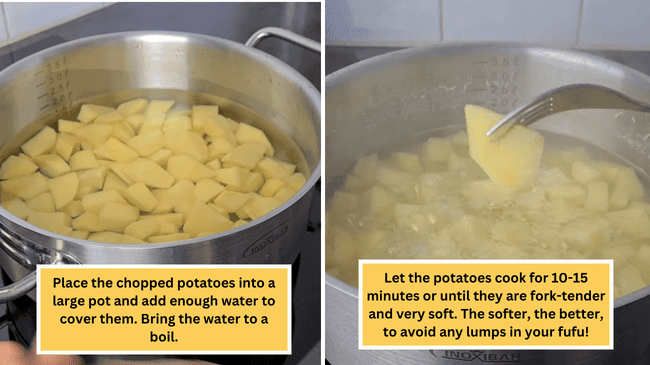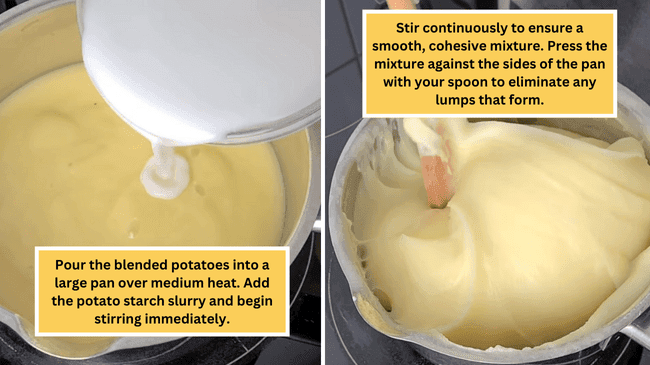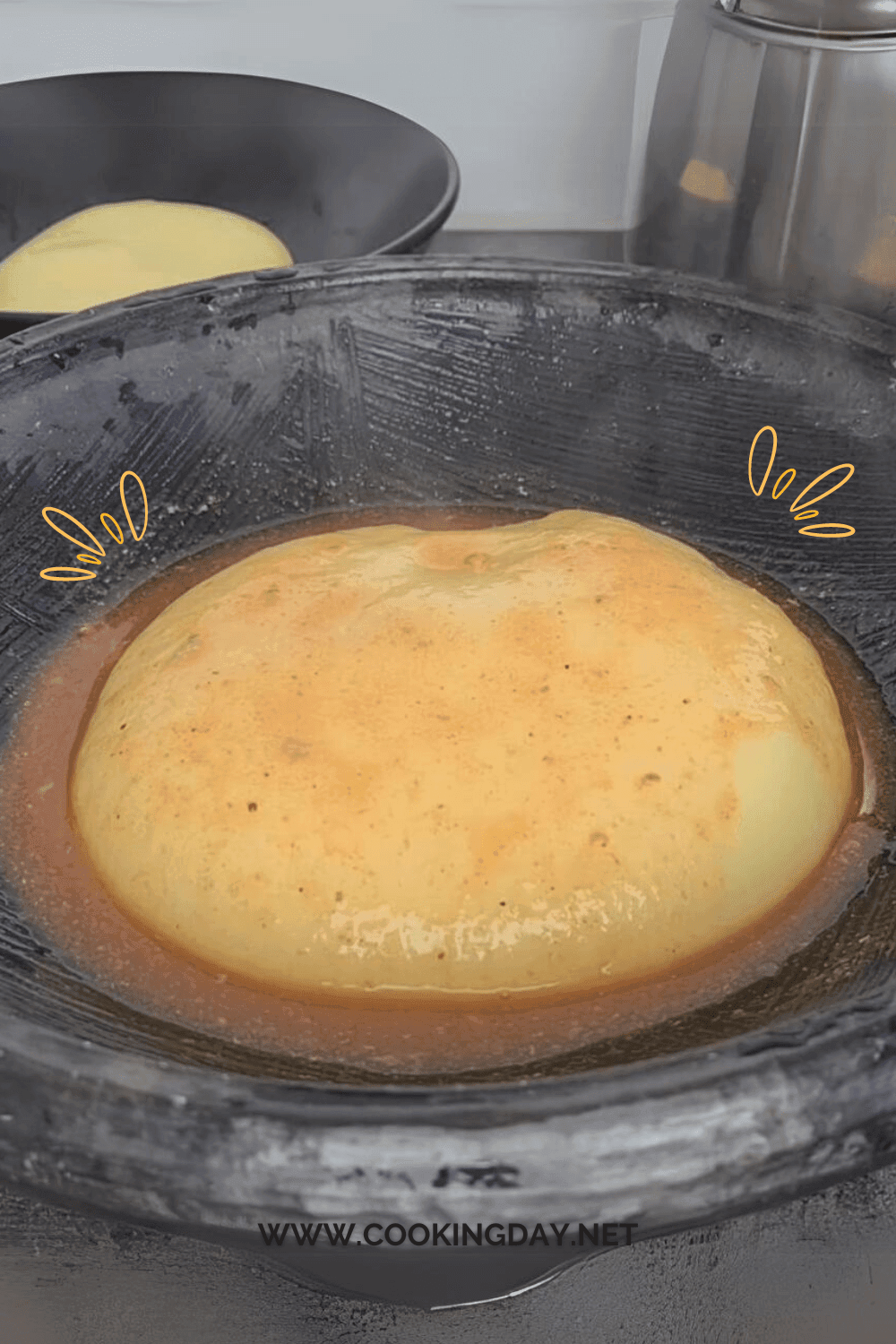Some links on this page are affiliate links. This means we may earn a commission at no additional cost to you if you click through and make a purchase, you can check our Affiliate Disclosure. Thank you for your support!
Looking for a fun and delicious alternative to traditional fufu? Well, say hello to Potato Fufu! This easy-to-make, homemade version will take your fufu game to the next level. It’s incredibly smooth, light, and pairs perfectly with your favorite African soups and stews. And the best part? You don’t need any fancy equipment, and the ingredients are simple—just good ol’ potatoes and potato starch! Get ready to wow your family with this fluffy side dish that’s sure to become a new favorite in your household. Let’s dive into this wholesome recipe!
Why You’ll Love This Recipe:
Simple Ingredients: Just potatoes and potato starch! No need for complicated or hard-to-find items.
Smooth & Velvety Texture: This potato fufu is ultra-smooth and soft, making it a perfect partner for savory stews.
Natural & Homemade: Ditch the boxed version! This recipe is made from scratch, so you know exactly what’s going into it.
Quick & Easy: Ready in under 30 minutes, this fufu is a breeze to prepare, even on busy weeknights.
Customizable: You can adjust the texture to your liking—firm, soft, or somewhere in between!

Ingredients & Their Benefits:
1 kg of Potatoes – Rich in potassium and vitamin C, potatoes form the base of this fufu. Choose starchy potatoes like Russets or Yukon Gold for the best mash.
2 Heaping Tablespoons Potato Starch – Potato starch helps give the fufu its elasticity and structure. It’s gluten-free and easy to work with.
Water – Essential for boiling and mixing, water helps cook the potatoes to perfect softness and keeps the fufu smooth and moist
Instructions:
Let’s bring the magic of homemade potato fufu to life! Grab your ingredients and let’s get started:
Step 1: Prepare the Potatoes
- Peel your potatoes and cut them into small, even pieces. Smaller chunks cook faster and ensure a smoother texture later.
- Rinse the potato pieces under cold water to remove excess starch.

Step 2: Boil the Potatoes
- Place the chopped potatoes into a large pot and add enough water to cover them. Bring the water to a boil.
- Let the potatoes cook for 10-15 minutes or until they are fork-tender and very soft. The softer, the better, to avoid any lumps in your fufu!

Step 3: Blend the Potatoes
- Drain the cooked potatoes and transfer them immediately to a blender or food processor. While the potatoes are still hot, blend until smooth. It might seem a bit runny at first, but don’t worry—that’s normal! It will firm up once combined with the starch mixture.

Step 4: Prepare the Starch Mixture
- In a small bowl, mix the potato starch with a little bit of cold water to create a smooth slurry. Make sure there are no lumps, as this will ensure the best texture for your fufu.

Step 5: Combine and Cook
- Pour the blended potatoes into a large pan over medium heat. Add the potato starch slurry and begin stirring immediately.
- Stir continuously to ensure a smooth, cohesive mixture. Press the mixture against the sides of the pan with your spoon to eliminate any lumps that form.

Step 6: Adjust the Texture
- As the fufu thickens, it will start to come together in a ball. If you prefer a firmer texture, gradually add more potato starch slurry. For a softer fufu, stick to the original amount. Adjust as needed until the fufu is just how you like it.
Step 7: Mold and Serve
- Once your fufu reaches the perfect consistency, transfer it to a slightly wet asanka or serving bowl. Mold it using a spoon or your hands. You can also use a light press to shape it, much like you would with a traditional mortar and pestle fufu.

Cooking Tips & Techniques:
Blend Hot Potatoes: Always blend your potatoes while they’re still hot to achieve the smoothest, lump-free consistency.
Stir Constantly: Keep stirring during the cooking process to prevent lumps from forming and ensure the fufu cooks evenly.
Adjust as You Go: Don’t be afraid to add more starch or water to get the texture exactly how you like it!
How to Serve It:
Potato fufu is the perfect accompaniment for rich and hearty stews. Here are a few pairing ideas:
Egusi Soup – The creamy, nutty flavors of egusi pair beautifully with the lightness of potato fufu.
Okra Soup – The slight stickiness of okra complements the smooth, silky texture of the fufu.
Groundnut Stew – A peanut-based stew is a dream combo with the velvety feel of this potato fufu.

Diet-Friendly Options:
Gluten-Free: This potato fufu is naturally gluten-free, perfect for anyone with gluten sensitivities.
Vegan: No animal products are used, so it’s a fantastic option for plant-based diets!
Low-Calorie Option: For a lower-calorie version, reduce the potato starch or replace some potatoes with mashed cauliflower.
ALSO READ: Elevate Your Baking Game by Discovering Flour Varieties
Best Ways to Store:
Fridge: Store any leftover fufu in an airtight container in the fridge for up to 3 days. To reheat, place the fufu in a microwave-safe dish, cover with a damp paper towel, and heat until warm.
Freezer: You can freeze potato fufu, but it may lose some of its smooth texture when thawed. Wrap portions tightly in plastic wrap, then place them in a freezer-safe container for up to 1 month.
ALSO READ: Amplify Your Kitchen’s Appeal with an Organized Pantry
Recipe Variations:
Cassava-Potato Fufu: Blend boiled cassava with the potatoes for a slightly firmer fufu.
Spiced Potato Fufu: Add a dash of garlic powder or a hint of ginger to the potato blend for an extra flavor punch.
Sweet Potato Fufu: For a sweeter, more colorful fufu, use sweet potatoes instead of regular ones.
ALSO READ: How to Make Authentic Fufu Recipe: A Beginner’s Guide to This Classic West African Dish

Potato Fufu Recipe 🥔✨
Equipment
- Knife
- Blender or food processor
- Stirring Spoon
- Asanka (optional for molding)
Ingredients
- 1 kg of potatoes suitable for mashing
- 2 heaping tablespoons potato starch
- Water for boiling and mixing
Instructions
- Prepare the Potatoes:Peel and chop the potatoes into small pieces. The smaller the pieces, the faster they will cook. Rinse them under cold water.
- Boil the Potatoes:Place the chopped potatoes in a pot, add enough water to cover them, and bring to a boil. Cook until the potatoes are very soft, about 10-15 minutes. Be sure to boil them thoroughly to avoid lumps in your fufu.
- Blend the Potatoes:Drain the cooked potatoes and transfer them to a blender or food processor. Blend while still hot until you get a silky-smooth texture. It may appear runny at first, but don’t worry—this will firm up later.
- Prepare the Starch Mixture:In a small bowl, mix the potato starch with a bit of cold water to form a slurry. Stir until smooth and free of lumps.
- Combine and Cook:Pour the blended potato mixture into a pan on the stove. Add the potato starch slurry and stir everything together over medium heat. Keep stirring as the mixture thickens. Press it against the sides of the pan to ensure a smooth, consistent texture.
- Adjust the Texture:Continue stirring until the fufu forms a cohesive ball. If you prefer a firmer texture, add more starch slurry gradually. If it’s too soft, add more starch; if it’s too stiff, reduce the starch next time.
- Mold and Serve:Once the fufu reaches your desired consistency, transfer it to a lightly wet asanka or serving bowl. Mold it using a spoon or your hands, similar to how you would with a mortar and pestle.
Notes
- For best results, blend the potatoes while they are still hot to avoid lumps. 🥣
- You can adjust the firmness of your fufu based on personal preference by adding more or less starch. 😊
ALSO READ: What Makes an Ideal Kitchen? Key Factors to Consider
Common Questions Answered:
Can I make this fufu without potato starch? While potato starch is important for achieving the desired texture, you can try using cornstarch as a substitute. However, it may not have the same elasticity as potato starch.
Can I prepare potato fufu ahead of time? Yes! You can prepare the fufu in advance and store it in the fridge. Reheat it gently on the stove or in the microwave with a splash of water to restore its texture.
What type of potatoes should I use? Starchy potatoes like Russet or Yukon Gold work best because they blend into a smooth, creamy consistency. Waxy potatoes might result in a gummier texture.

